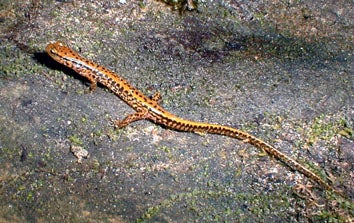SCIENTIFIC NAME:
Eurycea longicauda longicauda
STATUS:
Fairly common north of Tennessee River in Interior Plateau and Southwestern Appalachians. Lowest Conservation Concern.
DESCRIPTION:
Long-tailed salamanders have a slender body and can grow to a length of 7.4 inches as an adult. As the common name suggests, the species has a long tail which makes up more than half of its total length. The base color of the head, back and tail is yellow to yellowish orange. The sides and back have black or dark brown, irregularly shaped spots. The sides of the tail have dark colored vertical bars that create a “herringbone” appearance. This salamander has 13 to 14 costal grooves running along the sides of the body.
DISTRIBUTION:
Long-tailed salamanders can be found as far north as New York and as far south as northern Alabama. Their range extends as far west as Oklahoma and Kansas. In Alabama the long-tailed salamander is restricted to the areas north of the Tennessee River. South of the Tennessee River and in western portions of Lauderdale County an intergradient occurs between the long-tailed salamander and the closely related three-lined salamander (Eurycea longicauda guttolineata), which occupies the southern three-fourths of the state.
HABITAT:
Long-tailed salamanders can be found around caves, springs, seepages and streams, usually hiding under rocks and woody debris. These salamanders are often found in areas containing limestone and shale substrates.
FEEDING HABITS:
They feed on adult and immature insects, arthropods, worms, and other invertebrates.
LIFE HISTORY AND ECOLOGY:
Long-tailed salamanders breed in winter and produce a clutch of around 90 eggs. The adult female salamander attaches the eggs to stones or logs that are underwater. The female tends to the eggs and coils around them before they hatch. Long-tailed salamander larvae are often found in slow-moving streams and in woodland pools.
REFERENCES:
Mount, R. H., 1975. The Reptiles and Amphibians of Alabama. Ala. Agri. Expt. Sta., Auburn Univ., Auburn, AL. 347 pp.
New Jersey Division of Fish and Wildlife 2002. “Field Guide to Reptiles and Amphibians of New Jersey” (Online). http://www.nj.gov/dep/fgw/ensp/pdf/species/long-tailed_salamander.pdf.
Virginia Department of Game and Inland Fisheries 2012. “Virginia Wildlife Information: long-tailed salamander(Eurycea longicauda longicauda)”
AUTHOR:
Jonathon Bartlett, Wildlife Biologist, Alabama Division of Wildlife and Freshwater Fisheries






